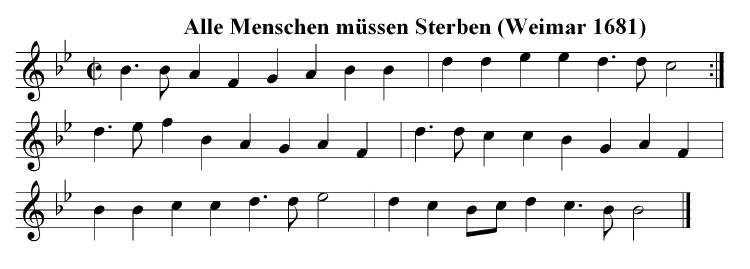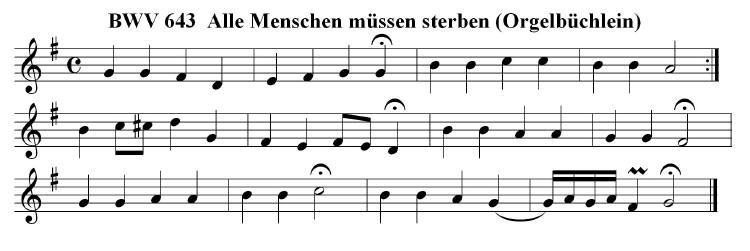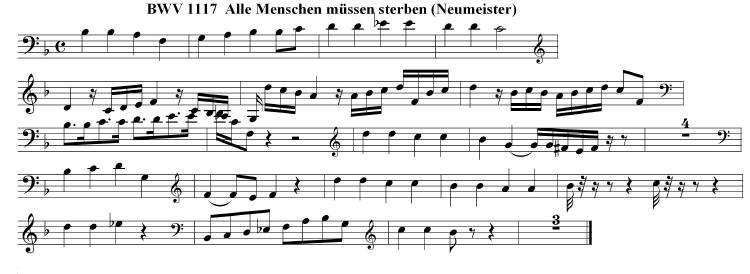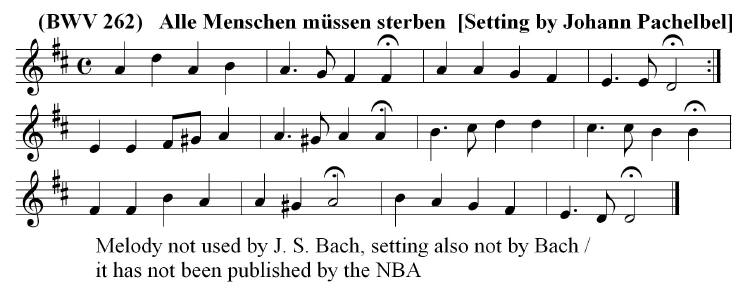|
Chorale Melodies used in Bach's Vocal Works
Jesu, der du meine Seele |
|
Melody & Text (Zahn 6804) | Use of the CM by Bach | Use of the CM by other composers
Chorale Melody (Zahn 6779a) | 1st Alternate Chorale Melody | 2nd Alternate Chorale Melody
Use of the CM by other composers | Arrangements/Transcriptions |
| |
|
Melody & Text: Zahn: 6804 | EKG: |
|
Melody and text by Johann Rist (1641) (Dürr claims that this was an original melody which appeared with the text - Rist, known primarily for his poetry and chorale texts, also did, as it appears, compose some original melodies, but more frequently he collaborated with composers {Andreas Hammerschmidt, Michael Jacobi, Martin Köler, Peter Meier, Heinrich Pape, the elder Johann Schop and Thomas Selle} in coming up with a good melody + text combinations.)
In the chorale cantata, BWV 78 “Jesu, der du meine Seele,” an unknown librettist used, without any changes, the 1st and 12th (last) verses of Rist’s chorale text and condensed the other verses to come up with the intervening mvts. of this cantata. |
| |
|
Melody: Zahn: 6804 |
|
This melody is identified as Zahn 6804, which has a variant in Bach’s works pertaining mainly to the final two lines of verse in the entire stanza. The chorale cantata BWV 78 and the final chorale in BWV 105 stand apart from the other variants which can be grouped together with this different ending. |
| |
|
At this point, the BWV Verzeichnis, asks the reader to make a ‘leap of faith’ and equate (an equal sign ‘=’ is used) the above melody with “Alle Menschen müssen sterben” and “Wachet doch, erwacht, ihr Schläfer.” For the latter chorale melody, I can find no record in Bach’s works whatsoever, while the former does yield some interesting material, but nothing that approaches an equivalent melody or melodic form. |
| |
|
Chorale Text 2: Alle Menschen müssen sterben |
|
This chorale text is generally attributed to either Johann Georg Albinus (1624-1679) or Johann Rosenmüller (1620-1684). The year of its first appearance as a text is 1652. It has always been associated with funerals and death. (By 1649 Rosenmüller was appointed to the official position in Leipzig of ‘Baccalaureus funerum.’)
A quotation from Martin Geck’s article on Johann Rosenmüller in the MGG1 makes clear the connection between these two men as well as an important connection to Bach:
>>Für angesehene Leipziger Bürger komponierte er seinem Amt gemäß Begräbnislieder; den Satz »Welt ade, ich bin dein müde« auf die Worte des Freundes Johann Albinus hat J. S. Bach unverändert in seine Kantate Nr. 27 aufgenommen.<< [“For respected Leipzig citizens, he {Rosenmüller} composed funeral/burial songs as required of him in his position. Rosenmüller composed the {5-pt.} setting of “Welt ade, ich bin dein müde” {“Good-bye world, I’m tired of you”} [Leipzig, 1649] based upon the words of his friend, Johann Albinus. Later J. S. Bach took Rosenmüller’s setting unchanged and placed it into his cantata BWV 27/6.”] However, this melody and text are entirely unique as is also, as far as I can determine, Rosenmüller’s 5-pt. setting of “Alle Menschen müssen sterben” [Leipzig, 1652] , the melody of which is not to be confused with any of the following melodies: |
| |
|
Use of the Chorale Melody by Bach: |
|
Text: Jesu, der du meine Seele | EKG:
Author: Johann Rist (1641) |
|
Ver |
Work |
Mvt. |
Year |
Br |
RE |
KE |
Di |
BC |
Score |
Music Examples |
|
1 |
BWV 78 |
Mvt. 1 |
1724 |
- |
- |
- |
- |
A130:1 |
- |
Mvt. 1 (Leusink) [ram] |
|
12 |
BWV 78 |
Mvt. 7 |
1724 |
296 |
188 |
297 |
84 |
A130:6 |
PDF |
Mvt. 7 (MG) [midi] | Mvt. 7 (Leusink) [ram] |
|
11 |
BWV 105 |
Mvt. 6 |
1723 |
- |
- |
- |
71 |
A114:6 |
PDF |
Mvt. 6 (MG) [midi] | Mvt. 6 (Leusink) [ram] |
|

|
|

|
|

|
| |
|
Untexted:
The following 4-pt. settings of “Jesu, der du meine Seele” all have the same final two lines differing from those settings above. These are very likely mvts. that have been rescued from cantatas which have been lost. There is no way to date these, but it is interesting that they are similarly different from those listed above. |
|
Ver |
Work |
Mvt. |
Year |
Br |
RE |
KE |
Di |
BC |
Score |
Music Examples |
|
- |
BWV 352 |
- |
? |
37 |
185 |
37 |
- |
F187.1 |
PDF |
Chorale (MG) [midi] |
|
- |
BWV 353 |
- |
? |
269 |
186 |
269 |
29 |
F187.2 |
PDF |
Chorale (MG) [midi] |
|
* |
BWV 354 |
- |
? |
368 |
187 |
369 |
245 |
F187.3 |
PDF |
Chorale (MG) [midi] |
|
* no title! |
|

|
|

|
|

|
| |
|
Text 2: Alle Menschen müssen sterben | EKG:
Author: Johann Georg Albinus (1652) |
|
Ver |
Work |
Mvt. |
Year |
Br |
RE |
KE |
Di |
BC |
Score |
Music Examples |
|
1 |
BWV 27 |
Mvt. 6 |
1726 |
150 |
350 |
150 |
- |
A138:6 |
PDF |
Mvt. 6 (MG) [midi] | Mvt. 6 (Leusink) [ram] |
|

|
| |
|
Chorale Melody: Zahn: 6779a | EKG: 329 |
|
The are three distinct melodies which can be identified beginning with Zahn 6779a
The composer of this melody was Christoph Anton who originally had composed it for a secular song by Johann Rist (1607-1667) entitled “Daphnis ging vor wenig Tagen” [“Just a few days ago Daphnis {the shepherd – this may be a reference to Rist himself} went out and…” – too bad that we will never find out what he had planned or had experienced on this adventure!] This song was published in 1651, but, unfortunately, a copy of the collection in which it appeared “Des edlen Daphnis aus Cimbrien besungene Florabella” [Hamburg, 1651], has never been found. The melody next appeared in a Weimar hymnal (melody source given below) in 1681 as a sacred piece/chorale with the text (only) by Albinus or Rosenmüller cited above.
For sources which Bach may have used, there are two which are of particular interest in coming to terms with organ works bearing this melody/text title: One from Weimar, 1681: |
|

|
|
and another from Weißenfels, 1714: |
|

|
| |
|
Untexted: |
|
Ver |
Work |
Mvt. |
Year |
Br |
RE |
KE |
Di |
BC |
Score |
Music Examples |
|
- |
BWV 643 |
- |
1713/15 |
- |
- |
- |
- |
K72 |
- |
|
|
- |
BWV 752 |
|
b 1740 |
- |
- |
- |
- |
|
- |
|
|
- |
BWV 1117 |
- |
b 1710 |
- |
- |
- |
- |
K190 |
- |
|
|
BWV 752 (doubtful): The BWV explains this as follows: “Trotz Echtheitszweifel werden zunächst noch aufgeführt:” [“Despite doubts about their authenticity, the following works/compositions are still listed for the time being: …BWV 752….”
BWV 1117: Only a patchwork of melodic fragments of the chorale melody can be located, but not a complete direct citation of the chorale melody. |
|

|
|

|
| |
|
First Alternate Chorale Melody: Zahn: 6783 |
|
(This has only a single documentation!) and appears only once in Bach's works: |
|
Text: Alle Menschen müssen sterben | EKG:
Author: Johann Georg Albinus or Johann Rosenmüller (1652)
Friedrich Smend gives Albinus, the BWVerzeichnis has Rosenmüller, Zahn was unable to trace this melody elsewhere; Schulze states that this was a variant which was only local in Thuringia. The reason for the confusion is too few reliable sources available; the NBA KB for BWV 162 does not even offer any conjecture – it discusses only a few variant text readings found in hymnals of Bach’s time. |
|
Ver |
Work |
Mvt. |
Year |
Br |
RE |
KE |
Di |
BC |
Score |
Music Examples |
|
7 |
BWV 162 |
Mvt. 6 |
1715/16 |
- |
18 |
- |
- |
A148:6 |
PDF |
Mvt. 6 (MG) [midi] | Mvt. 6 (Leusink) [ram] |
|

|
| |
|
Second Alternate Chorale Melody: Zahn: 6778 |
|
Untexted: |
|
Ver |
Work |
Mvt. |
Year |
Br |
RE |
KE |
Di |
BC |
Score |
Music Examples |
|
- |
BWV 262 |
- |
? |
153 |
17 |
153 |
- |
F8.1 |
PDF |
Chorale (MG) [midi] |
|

|
|
The NBA no longer recognizes this as a work by Bach. It is quite obviously a setting by Johann Pachelbel from 1683: Chorale Partita with 8 variations or ‘Partiten.’ The set of variations is introduced by a 4-pt. setting that is authentically by Pachelbel (with a subtitle: “Jesu, der du meine Seele.”) Possibly Pachelbel, in Nürnberg, used different melodies for “Alle Menschen müssen sterben” and “Jesu, der du meine Seele” than Bach ever did during his lifetime. This points to the substantial variations between different cities and regions in applying melodies to known texts. |
| |
|
Use of the Chorale Melodies by other composers: |
|
Jesu, der du meine Seele |
|
Reinhard Schwarz-Schilling (1904-1985)
Chorale for organ Jesu, der du meine Seele (1929) |
| |
|
Alle Menschen müssen sterben |
|
Johann Rosenmüller (c1619-1684):
5-pt. setting for voices Alle Menschen müssen sterben - this melody is unrelated to any of those listed above. |
|
Johann Pachelbel (1653-1706)
Chorale Partita for Keyboard Instrument on Alle Menschen müssen sterben, PWC 377 (containing a 4-pt. chorale setting with 8 additional variations - also with subtitle Jesu, der du meine Seele.) Zahn 6778 – see now defunct BWV 262 above. |
|
Georg Österreich (1664-1735):
Alle Menschen müssen sterben (1701), motetto concertato, SATBB, 3 ob, 4 str, 2 bn, bc (unknown choice of melody from the list above) is an extended multi-sectional work that contains the depiction of the valley of the shadow of death in Alle Menschen müssen sterben, set for two bassoons, two basses and continuo. [More detailed information given by Kerala J. Snyder and Geoffrey Webber in the Grove Music Online, Oxford University Press, 2005, acc. 8/19/05.] |
|
Johann Gottfried Walther (1684-1748):
Chorale Prelude for Organ Alle Menschen müssen sterben (using Zahn 6783) in DDT 26/27, p. 32 |
|
Georg Friedrich Kauffmann (1679-1735):
Alle Menschen müssen sterben Chorale Prelude for Organ (using Zahn 6779a with only a slight variation) [Leipzig, 1733]. |
|

|
|
Max Reger (1873-1916):
Chorale Fantasia for organ Alle Menschen müssen sterben Op.52/1 (1900) (using Zahn 6778)
Source: André Papillon: Index of Chorale Melodies in the Works of Johann Sebastian Bach (Les Presses de l'Université Laval, 2006) |
|
Paul Hindemith (1895-1963):
Sontata for trumpet and piano (1939) (using Zahn 6779a)
Source: André Papillon: Index of Chorale Melodies in the Works of Johann Sebastian Bach (Les Presses de l'Université Laval, 2006)
|
| |
|
Arrangements/Transcriptions of Bach's use of the Chorale Melody: |
|
Angela Hewitt (b 1958):
Arrangement for piano of the chorale “Alle Menschen müssen sterben” BWV 643 from Orgelbüchlein. In the liner notes to the album 'Bach Arrangements' she writes, "This is my own arrangement which I have played as an encore for many years". |
|
See list of Piano Transcriptions of BWV 78/1 by various composers/arrangers at:
Piano Transcriptions of Bach's Works - Index by BWV Number Part 1: Cantatas |
|
See list of Piano Transcriptions of BWV 643 by various composers/arrangers at:
Piano Transcriptions of Bach's Works - Index by BWV Number Part 4: Chorale Preludes for Organ |
| |
|
Sources: NBA, vols. III/2.1 & 2.2 in particular [Bärenreiter, 1954 to present] and the BWV ("Bach Werke Verzeichnis") [Breitkopf & Härtel, 1998]
The PDF files of the Chorales were contributed by Margaret Greentree J.S. Bach Chorales
Software: Capella 2004 Software, version 5.1.
Prepared by Thomas Braatz & Aryeh Oron (August 2005, March 2008, September 2008) |